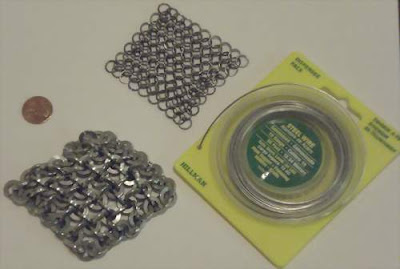And yet, as enjoyable as it was just to be able to build stuff, Friday's activities left me, well... unsatisfied. There was one very important item on my shopping list that I couldn't find, and that was the wire.
Yup. Plain old wire, of the sort that could be made into maille. Here's the trouble, though: to make good maille, you really need better wire than what you can find in most hardware stores. Yeah, you can find 16-gauge galvanized, and a lot of people do make their chainmaille from this material; but it's not the prettiest stuff around, and it does get that old-metal smell after you've been working it for a while, and while it starts out shiny, it doesn't take long to turn dull gray and stain your hands that color too.
So if you want your maille to look pretty, you need some better materials: you need stainless steel wire, or bronze, or brass, or nickel silver, or "bright" aluminum. The trouble is, it's not always easy to find good quantities of this stuff. You might get a little in a craft store, or you might not; you can't always tell in advance.
So I decided to go online and order from a place that specializes in maille-crafting supplies. I am now eagerly awaiting an order for three two-pound spools of 16-gauge wire: stainless steel, bronze, and nickel silver.
And this stuff is going to be delivered in two to three weeks. Weeks, I tell you! Good heavens, I've become impatient in my old age.
(I suspect my mother is reading this and thinking to herself, "What do you mean, become? You've always been like this....")
So earlier today I remembered that we had some wire hanging around from a project I did many moons ago, and I fished that out. Turns out it was 19-gauge galvanized steel. "Close enough", I thought, and I got out my mandrel.
Again, the girls pretty much dropped everything they were doing to come over and watch. I tell you, given how fascinated they are by all this, they're likely to be making maille one of these days.
And without too much trouble, I made over a hundred rings in under half-an-hour or so. Much to my surprise, every step of the process went as smoothly as everything I'd read online said: I wound up a big coil on the mandrel, then I cut off the ends and slipped the rod out, then I took the aviation snips and cut several links at a time off the coil. With the first several that I cut, I closed them into rings immediately after cutting them, to check to see how well they closed (and thus whether I was cutting them well), and everything looked really good--the cuts had a nice, flush surface, and they sealed up fairly tightly with little or no gaps.
So now that I had a small batch of rings, I got my pliers and set to work:
 Voila. There you have an honest-to-goodness swatch of European 4-in-1 (meaning that each ring not on an edge goes through four others.
Voila. There you have an honest-to-goodness swatch of European 4-in-1 (meaning that each ring not on an edge goes through four others.And, of course, I learned a few things. Just as I found with the whole lockwasher experiment from last week that your pattern can be too dense, so this time I found that your pattern can be too sparse. I'm using 19-gauge wire (0.040 inch thickness) on rings with an inner diameter of 0.25 inches, meaning that my Aspect Ratio (inner diameter divided by wire thickness) is 6.25--and that's a pretty high aspect ratio for the European 4-in-1 pattern. That means that the project is going to be too flexible, and thus isn't likely to ward off all those sword blows as well. Thankfully, the wire I ordered is 16-gauge (0.064 inch thickness), so the Aspect Ratio will be closer to 4. That will produce a denser, stiffer weave, but not too dense to work.
And if it doesn't work, I'll just get a thicker shaft for my mandrel. :-)
Anyway, I'll leave you with one more picture of my handiwork. Just for giggles I threw in the little lockwasher-weave that I did last week. I note how clunky and crude it looks next to the piece I did tonight. Interestingly, as different as they look, the rings on the two swatches had the same inner diameter; so had I done the same pattern, the pieces would have wound up about the same size for the same number of rings. (In fact, the new piece would have wound up slightly larger.) As it was, the new piece took 124 rings, compared to the 96 lockwashers in last week's project.
 I've also thrown in a penny for scale, and the coil of wire I used. Note how shiny the wire looks on its spool? And note how dark gray the maille looks that was made from it? That's how quick galvanized steel tarnishes when you work it like that, and why I'm going to try to avoid it on my projects.
I've also thrown in a penny for scale, and the coil of wire I used. Note how shiny the wire looks on its spool? And note how dark gray the maille looks that was made from it? That's how quick galvanized steel tarnishes when you work it like that, and why I'm going to try to avoid it on my projects.Anyway, despite the fact that my finished swatch feels to me less like armor and more like fireplace grate/curtain material, this was still a fun little project, and a good learning experience.
No comments:
Post a Comment